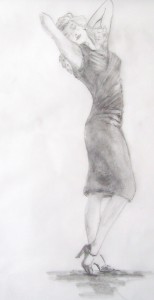
Here’s a quick sketch I did for the purpose of this blog. I sketched it from other studies I made some years ago from a painting I was attempting and never quite finished.
I don’t think there is an art instructor or book in the world that can teach you about drawing or painting the human figure. There are hundreds of books that teach you the basics but your drawing or painting is yours…and it is at each and every time that you attempt it.
I don’t know, it might be your mood and interpretation at the time. There is an endless variety of poses possible. For example, plan the standing figure carefully. Standing is a static pose, but an artist must suggest that it not only is capable of movement but will probably move very shortly; such as, the pose depicted to the left. Is she going to leave those arms in this position forever. No! There coming down…and soon.
(I remember at the time I first did this, I wasn’t that confident in drawing hands so I hid them in this pose. After a good deal of practice, fortunately, I no longer lack the confidence.)
Only when you draw your figure in a rigid moment do you arrest the latent movement. To relieve that “static” feeling, it helps to put the weight on one leg, twist the torso, tip and turn the head, or allow the figure to lean upon or be supported by something or someone. I go off the rule to not have the face and eyes looking straight–unless the composition requires it.
It is important that we, as artists, do not form a habit of always drawing or painting our figures always the same. A model can sit, lay down, or stand in a thousand different poses. Sketch them all. Someday you will be searching through your files for that one particular pose you need.
